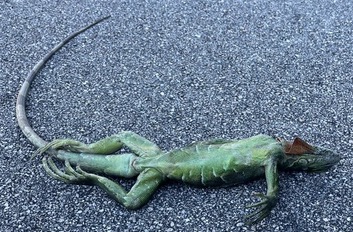Heather Ainsley
news@greenepublishing.com
Wednesday, Dec. 21 marked the official start of winter, and it took no time at all for the temperature to plummet, dropping well into the low thirties and even into the low twenties in places. While we may be struggling a little to adapt to this sudden, harsh temperature drop, our mammalian neighbors are well-adapted to handle the bitter-cold. While we can easily observe the genetic pre-dispositions of some wild animals and immediately think, “Oh, yeah, they are well-equipped,” the same cannot be said for some of our ectothermic neighbors, those animals who seemingly have no protection or defenses from the harsh conditions. But that's where we'd be wrong... Ectothermic animals are animals that cannot regulate their own body temperature by means of generating heat through metabolic activities. Their body temperature fluctuates according to the conditions in their surroundings.
Ectothermic animals are often called “cold-blooded” animals, and this grouping of animals includes invertebrates (those animals without a spine), fishes, reptiles and amphibians. So what happens to these ectotherms in winter? While any animal can certainly succumb to extreme weather conditions, our cold-blooded friends have certain adaptations that can keep them alive even in the harsh winter chill. Many invertebrates will hide themselves away, tucked into the vegetation or even underground or burrowed into old, rotten wood. (Ever wonder why you don't see as many bugs in winter?) Vertebrates like snakes, lizards, frogs, toads and newts have a secret survival technique to get them through bitter cold weather, called diapause.
Diapause is a period of suspended development, like hibernation, and it comes in handy during unfavorable environmental conditions. Reptiles and amphibians can slow down all of their bodily functions in cold weather, leaving them in a near comatose state. Before entering this state of inactivity, these animals will usually hide away, tucked in burrows underground or hidden under stones, logs or vegetation. While they are in this state, they don't have the ability to hunt or flee from predators, so their hiding place is usually a pretty good one. While in diapause, animals will live off of whatever fat stores they currently have in their bodies, and can survive without eating and barely moving for weeks. Sometimes, while an animal is in this inactive state, they become dislodged from their hiding place and find themselves exposed or out in the open. This can be very dangerous, as a reptile or amphibian who is in diapause will have limited function and will be unable to escape harm. If you happen upon a snake, lizard, or other “cold- blooded” creature on a brisk winter day, you may be surprised to find they don't try to get away, or even attack in their own defense.
Don't worry, they aren't sick; merely resting in a subdued state until the weather is more suitable. Leave any animals you find alone to do as nature allows. If they seem to be in danger, like on a public walkway, or in a position that would make them easy prey, you can relocate them to a nearby area that has plenty of cover for them. Cover them with leaves or other vegetation to help hide them, and let them be. Never assume a venomous reptile will not bite you just because it is cold, and if you aren't sure about the species of an animal, best to leave it where it is. It may be alarming to see a cold-blooded animal in a state of diapause, but rest assured it is a natural, life-preserving survival skill that has worked for generations of animals. The animal is not hurt, sick, diseased or dying, but it is vulnerable, so be kind. When the weather warms up, these animals will seemingly come back to life, as if nothing at all ever happened.

